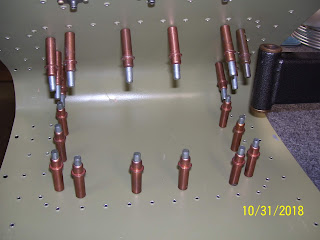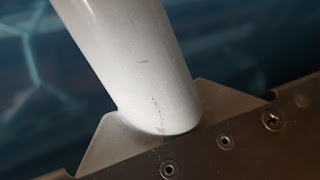I was really stressing over the position of the nut plate screw holes, and then, after all the measuring, marking, research, and second guessing everything, I suddenly realized something. The removable section of the skin is not really going to be all that "stressed" when compared to the rest of the outer skin. the subskin underneath is what is designed to handle the loads imposed over that portion of the LE. The removable section is just going to be a curved piece of aluminum that basically form fits over the subskin. There will still be some loads imposed by tension and compression due to aerodynamic forces of the air flowing over that section of the LE, and these loads will fluctuate based on the G-loading that is placed on the wing curing certain maneuvers, but again, the subskin is what is going to absorb the vast majority of these loads.
Because of this, I really do not need to fret so much over the location of the screw holes. That said, I had settled on 3 along each side and 4 along the rear edge to ensure that everything is held down firmly so that the removable section still aligns with the rest of the LE skin when it is screwed in place.
From my previous post, I also knew that I had to reposition the rear corner screw hole so that it was not placed directly in each corner, but placed on either side of the corner. One other thing that was causing me pain was that I was trying to prevent additional stress points by maintaining the existing rivet pattern as much as possible. As such, I was trying to maintain a line of screw holes along each side that would align the screw holes I had already drilled for the nutplates that will attach the fuel tank skin to the LE skin when the two sections are joined together. While this would hve almost worked well for the bottom side of the LE, this was not going to work all that well on the tops side of the LE, since the screw hole patterns differ just a bit on the top and bottom sides of the LE.So I decided to use the most-forward screw hole of the joiner plate area to align the most forward nut plates of the removable section as a starting point, and I chose to move the rear-most nutplate center hole 3/8 of an inch forward from the corners where the nutplate lines from the sides and the rear intersect each other. Then I decided to move the rear-most corner screw hole locations inboard about 3/4 of an inch from that same intersecting corner. This created the desired effect of offsetting the rear and side nut plates in each corner so that the screw holes would be on either side of the actual corner, but close enough that they should lock down the corners of the removable section with no problem.
Here is a close up one of the corners after measuring and drawing the approximate location of the nutplate by positioning it over the mark for the hole and tracing the outline of the nut plate so you can see what I am rambling about.
As you can see this provides plenty of clearance between each nut plate. Do not get confused by the drawing of the side nut plate where the end appears to be right over the corner again. You have to remember that the nut plates will actually be installed on the inside of the subskin to accept the screws from the outer skin. They are drawn here so that I know how they will be oriented on the subskin when I install them.
The next thing to resolve was the spacing between each of the nutplates along each side and the rear of the removable section on both top and bottom of the LE. As I previously mentioned, for the sides I chose the location for the most forward and most rearward nut plates, and then I more or less decided to split the difference of the distance between each of those locations for the location of the nutplate in the middle.
For the rear-most nutplates, after setting the two corner ones 3/4 of an inch inward from the intersection of the two nut plate lines, I then used a distance of 2 inches from each rear corner nutplate hole to position the next two inboard rear nut plates, and that left whatever distance in the middle, which was about 1 5/8 inches or so between those two nut plates. These distances are within the same distances where other similar nutplates are installed on the plane, so I feel pretty comfortable with the locations that I came up with.
here is the pic that shows how I aligned the forward-most nut plate holes with the existing holes in the joiner plate:
And here is a shot of the spacing between the rear-most nut plates, flipped 90 degrees the wrong way for some stupid reason:
Next is a shot of how the perimeter rivet holes for the skin and the nutplate screw hole locations looked after they were drilled with a #40 drill bit for starters . I once again used a center punch to mark each hole, and manually turned the #40 drill bit to start each hole before finishing it with the drill under its own power:
After all the perimeter and nut plate holes were drilled to #40, I then switched to a #30 drill bit to enlarge the holes for the nut plates, since the screw holes ultimately need to be drilled to #19 to accept the #8 screw. Here is a shot showing the clecoes in each of the enlarged holes for each nut plate. Unfortunately it came out blurry for some reason and I could not correct it.

Tonight I had made my decision about the gap in the corner for the outer perimeter rivets. I decided to do exactly as I stated in my previous post where I would add one more rivet to each corner but back it up just a bit so that the edge distance was consistent with each rivet on either side. SO I drew a line to bisect the 5/16 x 5/16 square that includes the rear-most corner, and then I took a ruler and measured along that line, and used the edge of the curved corner of the removable section that intersects with that line to measure another 5/16ths of an inch from that point outward, and marked that location for the rivet hole. The net affect of this is that it provides a rivet line with the same rounded contour of the removable skin, which is something I have also seen done in other areas of the build.
Here is the pic after the new corner holes were drilled to fill the gap:
And here is the entre bottom section with all the holes drilled and clecoed. From this you can start to get a better idea of what I am trying to do:
And another blurry one of the top side of the LE

With those holes done I was ALMOST ready to go ahead and enlarge the nutplate screw holes to their final size using a #19 drill bit. It was a good thing that I decided not to do that just yet. Just as has happened to me about a million times in the past, I started to think about the next steps after this was all done, and that major next step is to disassemble the LE and subskin and finally cut out the LE skin along the cut line marks and clean up the edges so they will accept the .025 removable skin that I would still need to fabricate. As I thought through this process it dawned on me that I would still need to figure out how to mark and drill the same screw holes in the new part. Unfortunately it looked like I was going to need to try to do this from the inside of the subskin, because the new removable skin would have to be fabricated from a new piece of aluminum, since the skin on the LE would be cut away and not really viable any longer - or so I thought.
Then, after thinking about it today, I realized that I can resort to a trick I have used before, by taking a file folder and cutting it to size to match the dimensions of the cutout section of the LE after I finish trimming it away. Then I can also use either the cut out section of the outer LE skin, or even the subskin holes to locate and drill the nutplate hole locations in the new file folder template. Then I can drill them out on the template and use it to outline the new removable section on a piece of .025 2024-T3 aluminum, match drill at least the first set of nut plate holes on the bottom side to start, and begin the process of form fitting the new part to the LE by attaching the bottom and wrapping it around the front of the LE to ensure that it is tight against the subskin, attaching the screws as I go.
SO, I can use the file folder template to ensure that I put the holes in the correct location on the new part that I must fabricate. I may have mentioned before that this part of the process is very similar to what one does when they place a landing light in the outboard section of the front of the LE. The only real difference is that the templates from most landing light kits for RVs are already created and so you just have to use the marks on the template that is provided. IN my case I am te one that has to create the entire template - just oodles and oodles of fun.
So the hole point of this ramble is that I should NOT enlarge the nutplate holes any further until the LE skin section is removed, and new part is fabricated so that I can match drill the removeable section and the subskin at the same time when I am finally ready to do that. SO those holes will remain sized to #30.
SO the next steps were to remove the LE assembly from the wing, remove the clecoes attaching the subskin, and debur all the new holes, and then dimple the outer perimeter rivet holes in the subskin and the outer LE skin. Then I will be ready to cut out the section that is to be replaced by the removable skin. Frankly, after all this time, I cannot believe that I am even talking about this. Of course the sad part is that I have all of this same thing to do on the right wing, and the thought of that is a bit daunting right now, knowing how long it has taken me to do this on the left wing.
Anyway, some pics after the LE was removed and the holes were deburred:
And finally the bottom and top side of the subskin after it was removed from the LE and the new holes were deburred. At least the hole placement for everything seems to have come out pretty nice. Now I just have to hope that I do not screw up cutting the section out of the LE skin!






























































